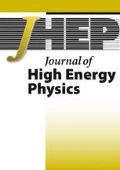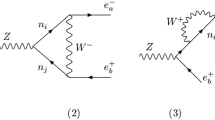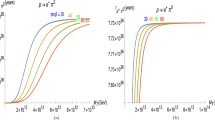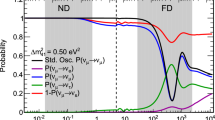Abstract
We evaluate the Schechter-Valle (Black Box) theorem quantitatively by considering the most general Lorentz invariant Lagrangian consisting of point-like operators for neutrinoless double beta decay. It is well known that the Black Box operators induce Majorana neutrino masses at four-loop level. This warrants the statement that an observation of neutrinoless double beta decay guarantees the Majorana nature of neutrinos. We calculate these radiatively generated masses and find that they are many orders of magnitude smaller than the observed neutrino masses and splittings. Thus, some lepton number violating New Physics (which may at tree-level not be related to neutrino masses) may induce Black Box operators which can explain an observed rate of neutrinoless double beta decay. Although these operators guarantee finite Majorana neutrino masses, the smallness of the Black Box contributions implies that other neutrino mass terms (Dirac or Majorana) must exist. If neutrino masses have a significant Majorana contribution then this will become the dominant part of the Black Box operator. However, neutrinos might also be predominantly Dirac particles, while other lepton number violating New Physics dominates neutrinoless double beta decay. Translating an observed rate of neutrinoless double beta decay into neutrino masses would then be completely misleading. Although the principal statement of the Schechter-Valle theorem remains valid, we conclude that the Black Box diagram itself generates radiatively only mass terms which are many orders of magnitude too small to explain neutrino masses. Therefore, other operators must give the leading contributions to neutrino masses, which could be of Dirac or Majorana nature.
Similar content being viewed by others
References
Super-Kamiokande collaboration, Y. Fukuda et al., Evidence for oscillation of atmospheric neutrinos, Phys. Rev. Lett. 81 (1998) 1562 [hep-ex/9807003] [SPIRES].
SNO collaboration, Q.R. Ahmad et al., Direct evidence for neutrino flavor transformation from neutral-current interactions in the Sudbury Neutrino Observatory, Phys. Rev. Lett. 89 (2002) 011301 [nucl-ex/0204008] [SPIRES].
KamLAND collaboration, K. Eguchi et al., First results from KamLAND: evidence for reactor anti-neutrino disappearance, Phys. Rev. Lett. 90 (2003) 021802 [hep-ex/0212021] [SPIRES].
IGEX collaboration, C.E. Aalseth et al., The Igex 76 Ge neutrinoless double-beta decay experiment: prospects for next generation experiments, Phys. Rev. D 65 (2002) 092007 [hep-ex/0202026] [SPIRES].
H.V. Klapdor-Kleingrothaus, I.V. Krivosheina, A. Dietz and O. Chkvorets, Search for neutrinoless double beta decay with enriched 76 Ge in Gran Sasso 1990–2003, Phys. Lett. B 586 (2004) 198 [hep-ph/0404088] [SPIRES].
CUORICINO collaboration, C. Arnaboldi et al., Results from a search for the 0νββ-decay of 130 Te, Phys. Rev. C 78 (2008) 035502 [arXiv:0802.3439] [SPIRES].
NEMO collaboration, J. Argyriades et al., Measurement of the double beta decay half-life of 150-Nd and search for neutrinoless decay modes with the NEMO-3 detector, Phys. Rev. C 80 (2009) 032501 [arXiv:0810.0248] [SPIRES].
GERDA collaboration, S. Schonert et al., The GERmanium Detector Array (GERDA) for the search of neutrinoless ββ decays of Ge-76 at LNGS, Nucl. Phys. Proc. Suppl. 145 (2005) 242 [SPIRES].
J. Schechter and J.W.F. Valle, Neutrinoless double-beta decay in SU(2) × U(1) theories, Phys. Rev. D 25 (1982) 2951 [SPIRES].
E. Takasugi, Can the neutrinoless double beta decay take place in the case of Dirac neutrinos?, Phys. Lett. B 149 (1984) 372 [SPIRES].
J.F. Nieves, Dirac and pseudo-Dirac neutrinos and neutrinoless double beta decay, Phys. Lett. B 147 (1984) 375 [SPIRES].
M. Hirsch, S. Kovalenko and I. Schmidt, Extended Black Box theorem for lepton number and flavor violating processes, Phys. Lett. B 642 (2006) 106 [hep-ph/0608207] [SPIRES].
M. Hirsch, H.V. Klapdor-Kleingrothaus and S.G. Kovalenko, R-parity-conserving supersymmetry, neutrino mass and neutrinoless double beta decay, Phys. Rev. D 57 (1998) 1947 [hep-ph/9707207] [SPIRES].
M. Hirsch, H.V. Klapdor-Kleingrothaus and S.G. Kovalenko, B-L violating masses in softly broken supersymmetry, Phys. Lett. B 398 (1997) 311 [hep-ph/9701253] [SPIRES].
H. Pas, M. Hirsch, H.V. Klapdor-Kleingrothaus and S.G. Kovalenko, A superformula for neutrinoless double beta decay. II: the short range part, Phys. Lett. B 498 (2001) 35 [hep-ph/0008182] [SPIRES].
G. Prezeau, M. Ramsey-Musolf and P. Vogel, Neutrinoless double beta decay and effective field theory, Phys. Rev. D 68 (2003) 034016 [hep-ph/0303205] [SPIRES].
F. Simkovic, J. Vergados and A. Faessler, Few active mechanisms of the neutrinoless double beta-decay and effective mass of Majorana neutrinos, Phys. Rev. D 82 (2010) 113015 [arXiv:1006.0571] [SPIRES].
F. Simkovic, private communication.
J. Bergstrom, A. Merle and T. Ohlsson, Constraining new physics with a positive or negative signal of neutrino-less double beta decay, JHEP 05 (2011) 122 [arXiv:1103.3015] [SPIRES].
J. van der Bij and M.J.G. Veltman, Two loop large Higgs mass correction to the ρ parameter, Nucl. Phys. B 231 (1984) 205 [SPIRES].
A. Ghinculov and J.J. van der Bij, Massive two loop diagrams: the Higgs propagator, Nucl. Phys. B 436 (1995) 30 [hep-ph/9405418] [SPIRES].
A. Ghinculov and Y.-P. Yao, Massive two-loop integrals in renormalizable theories, Nucl. Phys. B 516 (1998) 385 [hep-ph/9702266] [SPIRES].
R. Mertig and R. Scharf, TARCER: a Mathematica program for the reduction of two-loop propagator integrals, Comput. Phys. Commun. 111 (1998) 265 [hep-ph/9801383] [SPIRES].
Particle Data Group collaboration, C. Amsler et al., Review of particle physics, Phys. Lett. B 667 (2008) 1 [SPIRES].
V. Koch, Introduction to chiral symmetry, nucl-th/9512029 [SPIRES].
G. Bhattacharyya, H.V. Klapdor-Kleingrothaus, H. Pas and A. Pilaftsis, Neutrinoless double beta decay from singlet neutrinos in extra dimensions, Phys. Rev. D 67 (2003) 113001 [hep-ph/0212169] [SPIRES].
Author information
Authors and Affiliations
Corresponding author
Additional information
ArXiv ePrint: 1105.0901
Rights and permissions
About this article
Cite this article
Duerr, M., Lindner, M. & Merle, A. On the quantitative impact of the Schechter-Valle theorem. J. High Energ. Phys. 2011, 91 (2011). https://doi.org/10.1007/JHEP06(2011)091
Received:
Accepted:
Published:
DOI: https://doi.org/10.1007/JHEP06(2011)091




